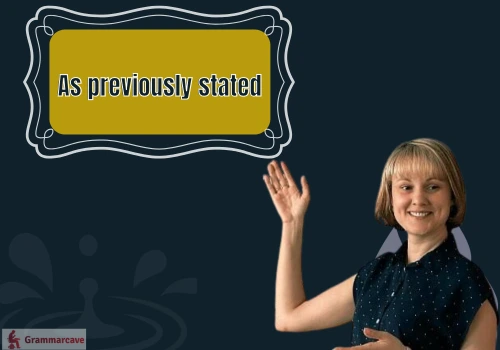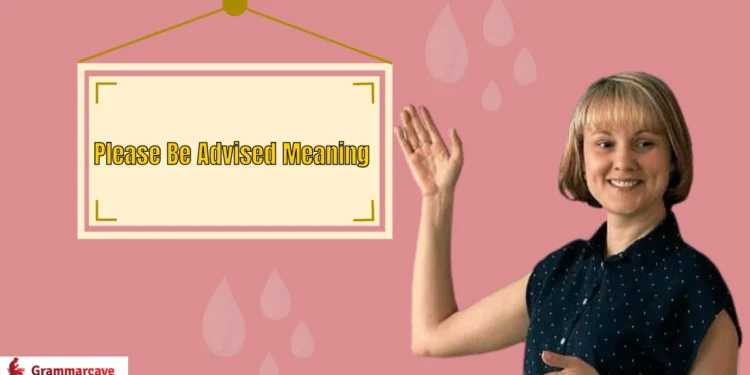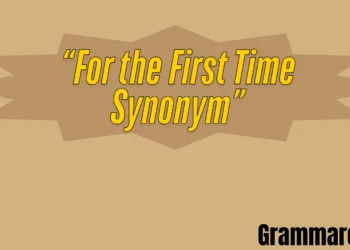In formal and professional communication, politeness and clarity must be maintained. A common phrase in corporate communications is *”Please be advised meaning.”* It is standard in legal documents and official correspondence and is used to notify readers of specific information, updates, or directives intended for them. While this phrase is standard across formal workplaces and legal systems, its context can change meaning drastically. It can be regarded as an appropriate courtesy, complaisance, or, conversely, as cold and overly formal.
Knowing whether to say *”Please be advised”* and what context to use it in versus a more casual alternative is essential in managing how the recipient perceives the information.
Is it polite and professional?
Yes, “Please be advised” is professional, polite, and somewhat formal and traditional. It is commonly used in business, legal, and official communications to introduce important information, warnings, or directives. While it maintains a respectful tone, modern alternatives like *”Please note,” “Kindly be aware,” or “We would like to inform you”* may sound more natural in everyday correspondence. The phrase remains useful in industries requiring strict clarity, such as *legal documents, compliance notices, banking communications, and government advisories*, where formality and precision are essential. However, simpler phrasing may improve readability and engagement in less formal settings.
What does it means? Is “Please be advised.
Like many other legal terms, “Please Be Advised” is widely used in professional contexts. This phrase is very often found in laws, business correspondence, simulations, and legal documents. It serves to legally draw attention or notify the recipient.
In a professional context, the term can be overly rigid and cold, like, “Please observe that your account will be undergoing maintenance on June 1.” Or it may transform into sentences such as, “Failure to respond before the deadline will lead to legal consequences.”
With the shift of context, the phrase becomes informal and goes along the lines of “Kindly be aware” or “Please note.” Such terms flow easier for the lips, unlike primitive words. But one can definitely not argue the strong rigidity and formality it brings, enabling professional industries to bring clarity amidst all the chaos and seek precision and discipline in every inch.
Advantages and Disadvantages of “Please Be Advised”

Advantages
1. Formal & Professional—Maintains a polished tone in official communications.
2. Clear & Direct—Immediately signal essential information.
3. Legally Appropriate—Often used in contracts and compliance documents.
4. Universally Understood—Recognized in corporate and bureaucratic settings.
5. Neutral Tone—Avoids emotional language, which can be helpful in sensitive matters.
Disadvantages
1. Can Sound Impersonal—It may be cold or robotic in casual settings.
2. Overuse Dilutes Impact—If used too often, it loses its urgency.
3. Passive Phrasing—Lacks the engagement of more conversational alternatives.
4. Not Ideal for Urgent Messages—A phrase like “Important Notice:” may work better for emergencies.
5. May Feel Outdated—Some modern workplaces prefer a more natural tone.
35 Different alternatives of “Please Be Advised”
1. To keep you updated
Meaning: Progress reporting
Definition: Periodic information sharing
Explanation: Maintains stakeholder awareness
Example: “To keep you updated, phase one is 75% complete.”
Best Use: Project status reports
Worst Use: Breaking news alerts
Tone: Routine, informative
2. To prevent any misunderstandings
Meaning: Preemptive clarification
Definition: Anticipates and addresses potential confusion
Explanation: Shows the sender’s awareness of the complexity
Example: “To prevent misunderstandings, the new policy doesn’t affect current staff.”
Best Use: Complex policy changes
Worst Use: Simple, unambiguous statements
Tone: Cautious, meticulous
3. “Please be informed that
Meaning: A formal and respectful way to convey information.
Definition: Used in professional and official communication.
Example:“Please be informed that your request has been processed.”
Explanation: Neutral and widely acceptable in business settings.
Best Use: Customer service emails, corporate updates, or official confirmations.
Worst Use: Informal chats where it may seem too stiff.
Tone: Polite, formal, and professional.
4. “For your awareness
Meaning: A professional way to share information without requiring action.
Definition: Used to keep someone informed without immediate follow-up.
Example:“To increase your awareness, the IT team will perform maintenance tonight.”
Explanation: Less formal than “For your reference,” often used in internal emails.
Best Use: Internal updates, FYI messages.
Worst Use: Critical alerts where action is needed.
Tone: Neutral, professional, and informative.
5. “Important
Meaning: A bold way to emphasize urgency or significance.
Definition: Used to flag critical information immediately.
Example:“Important: The deadline has been moved to Friday.”
Explanation: Stands out visually and contextually, often in headers or opening lines.
Best Use: Urgent announcements, deadline changes, or critical updates.
Worst Use: Routine or trivial updates where emphasis is unnecessary.
Tone: Urgent, authoritative, and direct.
6. For seamless communication
Meaning: Process optimization
Definition: Introduces protocols to improve information flow
Explanation: Often precedes tool/process changes
Example: “For seamless communication, we’re adopting Slack channels.”
Best Use: Tech/platform transitions
Worst Use: Criticizing current communication
Tone: Progressive, solution-oriented
7. “To inform you
Meaning: A straightforward way to share information.
Definition: Neutral and professional, though slightly blunt.
Example:“To inform you, your application is under review.”
Explanation: More direct than “We wish to inform,” suitable for factual updates.
Best Use: Status updates, procedural notifications.
Worst Use: Sensitive or negative news where empathy is needed.
Tone: Neutral, professional, and slightly impersonal.
8. “As a reminder
Meaning: A polite way to reinforce previously shared information.
Definition: Used to jog memory or stress compliance.
Example:“As a reminder, expenses must be submitted by Friday.”
Explanation: Less aggressive than “Be advised,” ideal for routine follow-ups.
Best Use: Deadline reminders, policy reinforcement.
Worst Use: First-time announcements where no prior context exists.
Tone: Polite, professional, and slightly repetitive.
9. “For clarity
Meaning: A professional way to eliminate ambiguity.
Definition: Used to restate or simplify complex information.
Example:“For clarity, only managers may approve these requests.”
Explanation: Positions the sender as helpful rather than corrective.
Best Use: Complex instructions, multi-step processes.
Worst Use: Simple or self-explanatory updates.
Tone: Professional, precise, and solution-oriented.
10. “As previously stated

Meaning: A pointed way to reference earlier communication.
Definition: Used to avoid redundancy or highlight ignored information.
Example:“As previously stated, all reports must use the new template.”
Explanation: It can sound passive-aggressive if overused.
Best Use: Follow-ups to non-responsive recipients.
Worst Use: First-time explanations or collaborative discussions.
Tone: Formal, slightly frustrated, and authoritative.
11. “To avoid confusion
Meaning: A preemptive way to clarify potential misunderstandings.
Definition: Used to simplify complex or contentious topics.
Example:“Only Team A will handle client calls this week to avoid confusion.”
Explanation: Proactively addresses ambiguity without assigning blame.
Best Use: Multi-team coordination, process changes.
Worst Use: Straightforward messages where confusion is unlikely.
Tone: Professional, proactive, and slightly defensive.
12. As part of our process
Meaning: Procedure explanation
Definition: Justifies workflow requirements
Explanation: Manages expectations about bureaucracy
Example: “As part of our process, we require three quotes.”
Best Use: Onboarding, SOP explanations
Worst Use: Innovative brainstorming
Tone: Systematic, explanatory
13. Quick update
Meaning: Brief, to-the-point information.
Definition: A concise notification.
Explanation: Signals efficiency; avoids lengthy details.
Example: “Quick update: The project deadline is now Friday.”
Best Use: Time-sensitive or busy contexts.
Worst Use: Complex issues needing elaboration.
Tone: Direct, informal.
14. So you know
Meaning: Ensuring awareness.
Definition: A conversational way to share facts.
Explanation: It often softens the delivery of minor news.
Example: “So you know, the printer is out of ink.”
Best Use: Low-stakes reminders.
Worst Use: Formal reports or serious announcements.
Tone: Casual, helpful.
15. FYI (For Your Information)
Meaning: Sharing info for reference.
Definition: A neutral, factual preface.
Explanation: Common in emails; may feel impersonal.
Example: “FYI, the budget report is attached.”
Best Use: Documentation or non-urgent notes.
Worst Use: Emotional or sensitive topics.
Tone: Neutral, detached.
16. To maintain clarity,
Meaning: Anti-confusion measure
Definition: Prefaces complex or potentially confusing information
Explanation: Signals careful communication
Example: “To maintain clarity, we’ll address points chronologically.”
Best Use: Multi-faceted explanations
Worst Use: Simple announcements
Tone: Methodical, patient
17. As a quick note
Meaning: Brief aside.
Definition: Signals a minor point.
Explanation: Keeps the focus on conciseness.
Example: “As a quick note, parking is limited tomorrow.”
Best Use: Emails or messages with multiple points.
Worst Use: Lengthy explanations.
Tone: Professional, efficient.
18. By the way
Meaning: Casual addition.
Definition: Introduces an afterthought.
Explanation: Often used in conversation.
Example: “By the way, I forwarded you the file.”
Best Use: Informal chats or emails.
Worst Use: Formal proposals (seems unplanned).
Tone: Relaxed, conversational.
19. I wanted to flag that
Meaning: Drawing attention.
Definition: Highlights an issue for consideration.
Explanation: Common in professional settings.
Example: “I wanted to flag that the timeline seems tight.”
Best Use: Problem-solving discussions.
Worst Use: Casual chats (may seem overly formal).
Tone: Professional, attentive.
20. For your records
Meaning: Documentation notice.
Definition: Indicates info should be saved.
Explanation: Used in administrative contexts.
Example: “For your records, here’s the invoice.”
Best Use: Formal emails with attachments.
Worst Use: Verbal conversations (redundant).
Tone: Official, dry.
21. Giving you a quick update
Meaning: Progress report.
Definition: A succinct status check.
Explanation: Often used in ongoing projects.
Example: “Giving you a quick update: The design is 80% done.”
Best Use: Team workflows.
Worst Use: Personal news (too impersonal).
Tone: Informative, neutral.
22. Wanted to mention
Meaning: Gentle reminder or note.
Definition: Introduces a point without urgency.
Explanation: Softens the delivery.
Example: “Wanted to mention, the deadline is flexible.”
Best Use: Collaborative environments.
Worst Use: Critical alerts (too mild).
Tone: Polite, considerate.
23. In case it helps
Meaning: Offering useful info.
Definition: Positions the note as assistance.
Explanation: Encourages receptiveness.
Example: “If it helps, I’ve included links to the resources.”
Best Use: Supportive or mentoring contexts.
Worst Use: Demands or directives.
Tone: Helpful, kind.
24. This serves as official notice that…
Meaning: Formal declaration of information
Definition: Legal/business terminology establishing an official record
Explanation: Creates documentation trail, often used in contractual or compliance matters
Example: “This serves as official notice that your lease will terminate on December 31.”
Best Use: Legal communications, policy changes, formal warnings
Worst Use: Casual team updates or personal matters
Tone: Authoritative, impersonal, legally binding
25. You are hereby advised that…
Meaning: Formal instruction or warning
Definition: Official language implying obligation or consequence
Explanation: Common in government/regulatory contexts, it emphasizes the recipient’s duty to acknowledge
Example: “You are hereby advised that failure to submit documentation may incur penalties.”
Best Use: Compliance alerts, regulatory requirements
Worst Use: Collaborative team settings (sounds authoritarian)
Tone: Bureaucratic, stern, procedural
26. This is a formal notification that…
Meaning: Unambiguous official communication
Definition: Direct statement creating a legal record
Explanation: Often precedes significant actions like termination or service changes
Example: “This is a formal notification that your account will be suspended.”
Best Use: Account actions, legal status changes
Worst Use: Positive news (e.g., promotions)
Tone: Grave, procedural
27. It is required to inform you that…
Meaning: Mandatory disclosure
Definition: Indicates legal/regulatory obligation to share information
Explanation: Used when withholding information could incur liability
Example: “It is required to inform you that this call may be recorded.”
Best Use: Privacy notices, compliance disclosures
Worst Use: Voluntary information sharing
Tone: Obligatory, impersonal
28. As per regulations
Meaning: Rule-based justification
Definition: Shortened formal reference to governing rules
Explanation: Efficient way to cite regulatory framework
Example: “As per regulations, all participants must complete safety training.”
Best Use: Industry-specific compliance (healthcare, finance)
Worst Use: Flexible situations requiring judgment
Tone: Technical, compliant
29. This constitutes notice that
Meaning: Legal documentation
Definition: Formalizes communication as legally recognized notice
Explanation: Used when specific notice periods are contractually required
Example: “This constitutes notice that we are exercising our option to renew.”
Best Use: Contractual notifications, lease agreements
Worst Use: Day-to-day operational updates
Tone: Legally precise
30. You are formally notified that
Meaning: Ceremonial notification
Definition: Emphasizes procedural correctness
Explanation: It often appears in disciplinary contexts
Example: “You are formally notified that this behaviour violates the code of conduct.”
Best Use: HR disciplinary actions
Worst Use: Positive recognition
Tone: Severe, ritualistic
31. Failure to comply may result in
Meaning: Consequence warning
Definition: Specifies penalties for non-compliance
Explanation: Used when escalation is possible
Example: “Failure to comply may result in account termination.”
Best Use: Terms of service, policy enforcement
Worst Use: Team motivation messages
Tone: Threatening, cautionary
32. To keep you in the loop
Meaning: Inclusion gesture
Definition: Maintains transparency in ongoing matters
Explanation: Project management staple that fosters collaboration
Example: “To keep you in the loop, the client requested new deliverables.”
Best Use: Cross-functional team updates
Worst Use: One-way directives
Tone: Collaborative, informative
33. For your review
Meaning: Feedback solicitation
Definition: Requests evaluation of attached materials
Explanation: Implies expectation of response/action
Example: “For your review, I’ve attached the contract draft.”
Best Use: Document collaboration
Worst Use: Urgent action items
Tone: Professional, expectant
34. To ensure transparency
Meaning: Open communication declaration
Definition: Prefaces potentially sensitive information
Explanation: Builds trust through voluntary disclosure
Example: “To ensure transparency, the budget has been reduced by 15%.”
Best Use: Leadership communications
Worst Use: Routine non-sensitive updates
Tone: Vulnerable, honest
35. As a matter of record
Meaning: Official documentation
Definition: Formalizes statements for future reference
Explanation: Creates paper trail without immediate action
Example: “As a matter of record, the board opposed this measure.”
Best Use: Meeting minutes, historical documentation
Worst Use: Verbal conversations
Tone: Archival, factual
36. To bring you up to speed
Meaning: Context provision
Definition: Quickly orients recipient to the current status
Explanation: Assumes information gap exists
Example: “To bring you up to speed, we’ve pivoted to Plan B.”
Best Use: New team members, post-absence updates
Worst Use: Repeating known information
Tone: Helpful, concise
FAQs
1. When should I use “FYI” vs. “Just letting you know”?
Answer:
- FYI, it is neutral and best for emails/documentation.
- Just letting you know is more conversational (Slack/verbal).
- Example:
- FYI: Attached is the report. (Email)
- Just letting you know—I’ll be offline tomorrow. (Chat)
2. Is “Heads-up” too informal for clients?
Answer:
Depends on the relationship:
- Casual clients: “Quick heads-up: Your order shipped early!”
- Formal clients: “I wanted to notify you in advance that…”
3. How do I soften “As per our agreement”?
Answer:
- Less rigid: “As we discussed earlier…”
- Collaborative: “Following up on our agreed plan…”
4. Can “For your records” sound cold?
Answer: Yes. Warm it up:
- “For your records—let me know if you need anything else!”
5. What’s a professional alternative to “By the way”?
Answer:
- “Additionally,…” (Email)
- “On a related note,…” (Meetings)
6. Is “Thought you should know” dramatic?
Answer: It can be. Use:
- “This may be relevant to you:…” (Neutral)
- “Flagging for your awareness:…” (Professional)
7. When is “In case you weren’t aware” appropriate?
Answer: Only for legitimate knowledge gaps:
- “In case you missed the announcement”
- “In case you weren’t aware, coffee is in the kitchen.” (Patronizing)
8. How formal is “Under our agreement”?
Answer: Very formal. Use for:
- Contracts
- Legal notices
- Compliance
9. Can I use “Quick update” in emails?
Answer: Yes, but:
- Subject line: “Quick update: Project X timeline”
- Avoid complex issues needing detail.
10. Is “Failure to comply” too harsh?
Answer: Use only for:
- Legal/HR warnings
- Safety violations
- Softer alternative: “Please note that non-compliance may affect…”
11. When should I use “To ensure transparency”?
Answer: When disclosing sensitive info:
- “To ensure transparency, the budget was cut by 10%.”
12. Can “Just a heads-up” be used in emails?
Answer: Yes, but sparingly. Better for:
- Internal teams
- Non-urgent alerts
13. What’s a better phrase than “As per regulations”?
Answer:
- “To comply with [specific regulation]…”
- “Under [law name], we must.
14. What’s the most versatile professional phrase?
Answer: “For your awareness.”
- Works in emails, chats, and meetings
- Neutral tone
- Flexible for urgent/non-urgent info
Conclusion: The Role and Appropriateness of “Please Be Advised”
In formal communication, especially in law and business, “please be advised” has stood the test of time. Its primary purpose is to draw attention to important details so the recipient appreciates essential and potentially life-changing information, precautions, or instructions. Although it is framed in professional politeness, it is also perceived as excessively formal in more relaxed professional settings.
In legal texts like legal contracts, company strategies, and financial papers,* the phrasing aids in marking compliance, which fulfils the documents’ legal prerequisites. Nevertheless, dealing with clients or other staff members within the informal social office setting uses softeners such as “to inform you” and even “for your awareness.” Softeners, as such, improve communication significantly.
From the earlier highlighted talk, it may be noted that the phrase “Please be advised” can be studied based on the context, the speaker’s culture, and the level of formality required. In this situation, and with the correct application of softeners, “please be advised” enhances the statement’s professional level while remaining dispassionately polite towards the subject. To achieve maximum effect, traditional patterns and modern expressions should be balanced.








